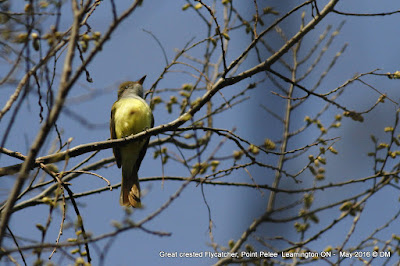On Saturday April 30, twenty-two intrepid Windsor-Essex Field Naturalists (EFCN) met at the Leamington docks for a two-day, one-night adventure to Pelee Island. Young or Old, woman or man - we all had one thing that we all had in common, we were about the embark on a voyage that celebrates the natural history of Pelee Island. We boarded the
MV Jiimaan ferry were soon plying the waters of Pigeon Bay making the 10 km ride south to Pelee Island.
Orientation
Upon arriving to the island we boarded a school bus and drove towards our lodging provider: the Anchor Wheel Inn (
www.anchorwheelinn.com) where we had lunch and dropped off our luggage. Our trip was let by David Kraus - who has led this trip for many years and is a landowner on the island. While we drove around on a chartered school bus, David's daughter Megan challenged the group to answer some riddles and puns. No doubt she will be a great naturalist when she gets bigger.
Kraus Property
Our first destination was the Kraus Property. This 30-acre property was formerly a crop field which has been naturalized with the help of local environmental groups and landowner stewardship programs- along with a willingness by our group leader and property owner David Kraus. Birds seen include an Egret, three Red-tailed hawks, a Peregrine Falcon and Spotted Sandpiper. Fox Squirrels were seen. David Kraus showed us the various habitat improvements that were made on the property including Hibernacula - specialized rock piles that give snakes an ideal place to overwinter safely. Small ponds along with various sized nest boxes. Pit and mound excavation creates small habitats to increase site diversity. Locally sourced Kentucky Coffee trees were noted as well.
Lighthouse provincial nature reserve
Our next destination was the lighthouse preserve which features a large triangular shaped marsh surrounded by beach dune habitat. This reserve is on the northeast corner of the island and almost reaches back towards Point Pelee on the mainland. At the north-most tip of this park is a beautiful lighthouse which was constructed in 1833. The lighthouse seems to be tilting a little- a reminder of how dynamic the Lake Erie shoreline can be. Huge Hackberry trees were abundant along the pathway that lined this park. During this particular part of the trip - the weather became cold, windy and rainy- and we may have been rushed a little more than normal - which unfortunately prevented us from appreciating the flora and fauna that surrounded us. A Belted Kingfisher, along with about four Yellow-rumped Wablers were noted as we walked briskly back to our awaiting bus.
Red Cedar Savanna
Even though it was cold and raining in the late Saturday afternoon, we continued on to Red Cedar Alvar which provided an abundance of reptile observations. Some large flat rocks that we inspected were sheltering Dekays Brownsnake, along with Garter Snakes - one being melanistic. Later on during our walk, we found a Blue Spotted Salamander. Spring Cress and Dutchman's Breeches wildflowers were noted along the pathway. Blue Jays, Chickadees, Yellow rumped Warblers and a late Eastern Phobe greeted us as we walked the trails.
Fish Point Nature Reserve
Sunday morning, we visited the Fish Point Nature Reserve. Some highlights included breathtaking wet swamp forest, large areas of Trilliums, and a trail that meandered into a biodiverse section of forest and marsh edge habitat. We were greeted by a singing Eastern Towhee, then small groups of warblers (mainly Yellow Rumped, Palm, with a few Chickadees and Blue headed Vireo). This trail then led to the tip of Fish Point - which is (as one would expect) very similar to the habitat at Point Pelee's tip. But Fish Point's tip , but does not have trails or signs. Its a little more untouched and natural than mainland Pelee - which has generous trail paths carved out for huge numbers of tourists that visit that park. The sandy tip allowed for some of our group members a good 50m walk on the tip sandbar - something that we have not done at Point Pelee for quite some time. Mainland Pelee seems to be suffering from more erosion than deposition as of late. A walk back down the beach and along the roadway gave our best birdwatching opportunity on the trip - Yellow Warbler, Rose breasted Grosbeak, House Wren and Hermit Thrush - along with Black and White Warblers added some much needed checks on our meager trip bird list. Red Admiral Butterflies were seen along the edge of the beach as well.


Stone Road Alvar
Limestone pavement jutting out into lake erie made for an interesting beach. Nature highlights here included a Lake erie watersnake (found by Sarah B. and Megan), Savanah Sparrow, Spotted Sandpiper.
Sheridan Point & the Old Query
Our trip ended off with one last trip to Sheridan Point - just around the corner from our lodging location. Blue spotted salamander was seen again - this time 4 specimens were found. Dave reminded us that when looking under rocks, or even walking on rocks, one must be careful not to harm snakes or salamanders by "dropping" the rock back on the animal. Its best to encourage the animal to move out of the way before setting the rock or cover back into place. We walked around the old quarry which was abundant in Hackberry and Kentucky Coffee trees.
Conclusion
Our group thoroughly enjoyed this trip led by David Kraus. The food, lodging and transportation were well organized and the company was excellent. Just being able to discover this island is something that any Essex county nature enthusiast should take part in. Our total bird list totalled 67 species, a little lower than average. Thank you again to David Kraus and thank you to ECFN for organizing this great annual trip.





















































